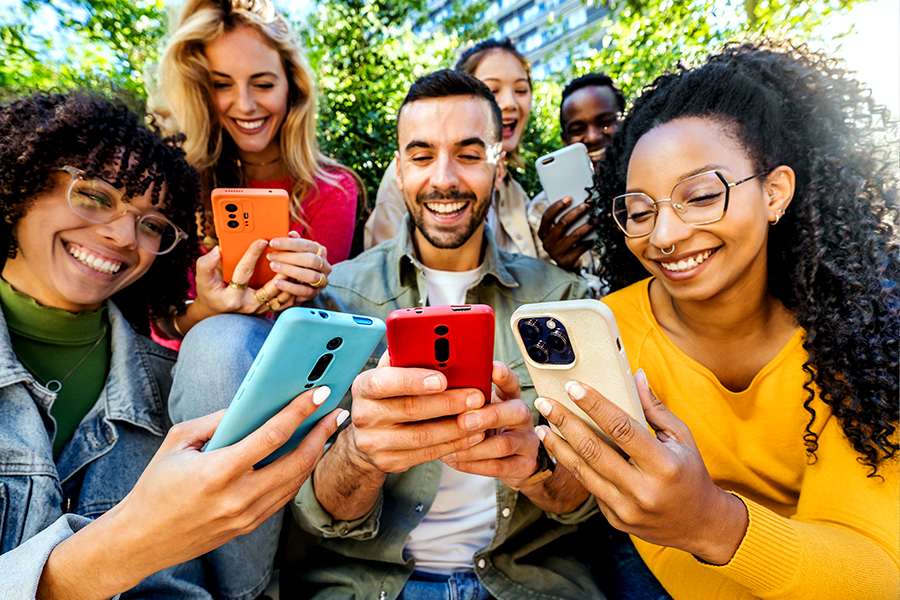
To make influencers seem more authentic, just add #friends
Instagram personalities see a boost in engagement when they post about their close relationships
 Influencer marketing has exploded. In 2016, there were more than 1.2 million sponsored posts on the social media platform. By 2020, that number had nearly quintupled.
Image: Shutterstock
Influencer marketing has exploded. In 2016, there were more than 1.2 million sponsored posts on the social media platform. By 2020, that number had nearly quintupled.
Image: Shutterstock
Every morning when Yu Ding arrives at Stanford Graduate School of Business, he snaps a photo of an elm tree between the faculty buildings. His Instagram is a motif of the same tree surrounded by the same sidewalk, day after day.
“I don’t have many likes,” the assistant professor of marketing admits.
The two marketing researchers couldn’t help but wonder: Did the same pattern hold true for Instagram influencers with millions of followers? And if it did, what were the implications for the booming field of influencer marketing?
These are the key questions that Ding, Chung, and coauthor Ajay Kalraopen in new window, also at Jones Graduate School of Business, set out to answer in a recent paper. They found that when Instagram influencers include their close friends, family, and romantic partners in posts, it boosts their engagement.
“People want to feel a connection,” Ding says. “If you post your close social ties, people feel they can connect with you.”
With a Little Help from My Friends
Influencer marketing has exploded. In 2016, there were more than 1.2 million sponsored posts on the social media platform. By 2020, that number had nearly quintupled. Last year, companies spent more than $16 billion on influencer marketing strategies — no surprise, considering 60% of marketers believe this approach has a higher return on investment than traditional advertising.Despite the frenzy, the field remains relatively unexplored, and researchers are just starting to understand the secrets behind influencers’ engagement. That’s changing quickly, though. “You have to work fast because this is a hot topic that companies are urgently seeking answers for,” Ding says.
To figure out whether including friends and family in posts really improves engagement, Ding and his coauthors analyzed data from Instagram influencers whose accounts were in the top 1,000 most followed. They sorted more than 55,000 posts based on whether the text mentioned a close friend, family member, or romantic partner, and by how many people appeared in each photo. Several social media–savvy research assistants checked a sample of the data to ensure these classification methods were sound.
This research found that posts that mentioned close social ties in their text received nearly 9% more engagement, as measured by likes per follower. That might not seem like a lot, but if you’re Portuguese soccer star Cristiano Ronaldo, that’s nearly 2 million more people interacting with your post. They also found that posts that pictured two to three people were the most popular.
Three images, one of a solo influencer standing against a metallic background. The second image is the same influencer standing with two friends. The third image is the same influencer standing with a group of six friends..
Me and the boys: Researchers created simulated posts featuring a gamer with more than 7 million Instagram followers to see which one people found most likable. An image of him with two friends had the highest engagement.
To prove causality, the researchers conducted a series of experiments where they altered posts by influencers like actor and entrepreneur Jessica Alba and YouTuber David Cánovas Martínez to see which images and text engaged study participants more. These experiments proved that posts that reference influencers’ close friends, family members, and romantic partners do the best job of capturing likes.
Ding, Chung, and Kalra explored a few possible reasons why we’re drawn in by glimpses of influencers’ time with besties and loved ones. Sharing moments from real relationships can help influencers come across as more authentic, and we crave authenticity. These moments can also make influencers seem warmer and more relatable — think, “Stars — they’re just like us!” Lastly, as hypothesized by the researchers, humans are naturally nosy, and getting a window into influencers’ personal lives can be a tantalizing prospect.
Also read: Trust in the age of influencers
Rules of Engagement
Ding says it would be a mistake if the lesson brands and influencers take away from this research is to always post photos with two to three people, captioned with mentions of family, friends, and partners. “We don’t want to give people a shortcut to game the system,” he says. “When you are trying to cast an image of your brand, of your product, what do your consumers value? You have to really understand that they value social connection and authenticity, especially in the context of influencer marketing.”There is, of course, an inherent tension between feeling like someone is trying to share their life with you authentically and feeling like they are trying to sell you something. Ding’s research also found that when influencers include close social ties in their sponsored posts, it mitigates the negative response that followers often have to posts featuring product placement or branded content.
He plans to continue exploring these effects, including their possible downsides. For example, when social media personalities post misinformation alongside posts that show close friends, family, and romantic partners, is the audience more likely to engage with it? “What if they should not have engagement in a certain context?” Ding asks. Also, what happens if influencers and brands stretch this approach too far? Will it erode their authenticity, making fans feel manipulated? These are questions he’s asking as part of a broader research agenda focused on how people evaluate information and how entities build and lose trust.
Ding believes that social media has the power to bring people together. Even when brands are leveraging platforms and influencers for business purposes, “let’s still focus on the social connection part of anything that you’re going to do,” he says. “We don’t want business to become the enemy of organic enjoyment of life. In fact, marketing can contribute uniquely to this by understanding and reflecting what consumers truly value.”
Ding still posts a photo of that one tree when he gets to work. But now, he’ll sometimes add a second photo, like a shot of him catching up with a friend over breakfast. Those posts typically get more likes, which helps Ding feel more connected with his circle of followers. “I’m happy with that, being an authentic, relatable, warm, and sometimes engaging ‘influencer’ myself,” he says.
This piece originally appeared in Stanford Business Insights from Stanford Graduate School of Business. To receive business ideas and insights from Stanford GSB click here: (To sign up : https://www.gsb.stanford.edu/insights/about/emails ) ]
Post Your Comment

















